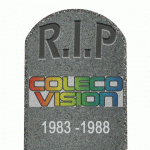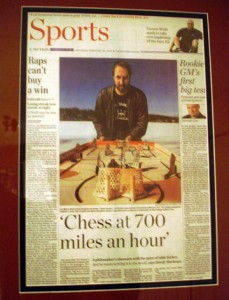By the late 1980s, Coleco was out of business. Instead of backing table hockey — a sure thing — they risked their future on fads like Cabbage Patch dolls, and on electronic games like Colecovision. Fads come and go. Electronic games are more than a fad, but Colecovision could not compete with Nintendo.
Classic table hockey never died — it just moved underground during the 1990s. Dedicated players and organizers maintained their vintage Coleco boards in tip-top tournament condition. Champions like Martin Labelle ran a league in Sherbrooke, and so did Burt Brassard in Quebec City. John Beedham and Pete Moulton hosted an annual invitational tournament, the “Johnny Good Guy.” Rich Thill restored classic boards in Chicago, for Jim Rzonka’s league, while A.J. Sarma did the same in L.A.
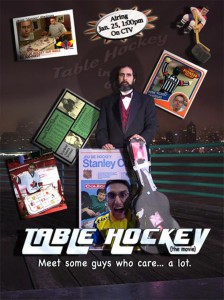 Near the turn of the 21st century, two developments helped spur the revival of Classic table hockey: the IT revolution, and Table Hockey: The Movie. The internet and world wide web allowed players to communicate and network; while the Table Hockey: The Movie, directed by Thor Henrikson, accomplished many things.
Near the turn of the 21st century, two developments helped spur the revival of Classic table hockey: the IT revolution, and Table Hockey: The Movie. The internet and world wide web allowed players to communicate and network; while the Table Hockey: The Movie, directed by Thor Henrikson, accomplished many things.
The movie, premiered on CTV on January 25, 2004, inspired Martin Labelle to build a batch of customized 5380 tables, enough to seed leagues and tournaments all over the Classic table hockey map. This movie also provoked a 2009 showdown between Lou and Swedish Stiga masters (see below).
You can watch the movie here: Table Hockey: The Movie (run time 45:56)
Soon after the Table Hockey Movie aired, in late January 2004, Lou was featured on front page of the Toronto Star’s sports section — every man’s dream! They even sent Sports Illustrated photographer David Bergman to take the “money shot.”
The Star ran a huge photo front and center, with the title “Chess at 700 Miles an Hour,” and an insightful story by Randy Starkman. This meaty table hockey saga was flanked by a thin NBA column on the left, and a thin NHL column on the right. Only in Canada could this happen!
You can read the story here: Chess at 700 Miles Per Hour,
by Randy Starkman, The Toronto Star, February 28, 2004.
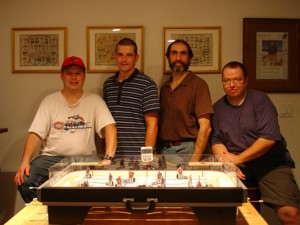
In 2005, Carlo Bossio, Denis Begin, and Martin Labelle founded Hockey sur Table Quebec, which showcased the talents of a new generation of Classic table hockey superstars: Carlo and Gino Bossio, Martin Labelle, Pat Cote, Dany Leclerc, as well as Sam and Alex Anoussis once they rejoined the fray.
Lou came out of retirement in 2006. He immediately faced two challenges: first, playing on today’s faster and more powerful boards, competing against a new generation of supremely talented players.
Here on the right, practicing for a New York tournament: Burt Brassard, Martin Labelle, Lou Marinoff, Denis Begin. The board itself is a Labelle-Coleco, inspired by the Table Hockey Movie.
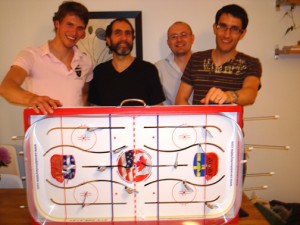 Lou’s second challenge involved a showdown with Swedish Stiga masters Hans Osterman and Lars Fridell, who had trash-talked Canadian and US table hockey in the 2004 Table Hockey Movie.
Lou’s second challenge involved a showdown with Swedish Stiga masters Hans Osterman and Lars Fridell, who had trash-talked Canadian and US table hockey in the 2004 Table Hockey Movie.
Lou caught up with the Swedes in Stockholm, in 2009. The results of that encounter form a trilogy on Lou’s YouTube channel: Canada Rocks. As one pundit remarked, Lou was “the right man for the job.”
Canada Rocks Part One: The Challenge
Canada Rocks Party Two: The Revival
Canada Rocks Part Three: The Showdown
When he saw this trilogy, Martin Labelle sent Lou an email: “Mission accomplished.”
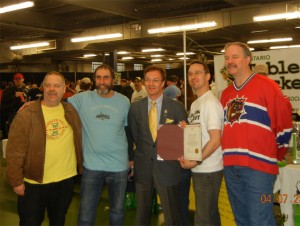 Thanks to its 21st century revival, table hockey is once again flourishing: It’s bigger and better than ever! A 2012 tournament in Toronto, organized by Mark Sokolski, attracted more than 100 players, boys and girls alike. The “old guard” turned out to support it, including players and organizers who were active in the 1970s. In the pic: Ron Marsik, Lou Marinoff, Bob Delaney, Mark Sokolski, Mike Pope.
Thanks to its 21st century revival, table hockey is once again flourishing: It’s bigger and better than ever! A 2012 tournament in Toronto, organized by Mark Sokolski, attracted more than 100 players, boys and girls alike. The “old guard” turned out to support it, including players and organizers who were active in the 1970s. In the pic: Ron Marsik, Lou Marinoff, Bob Delaney, Mark Sokolski, Mike Pope.
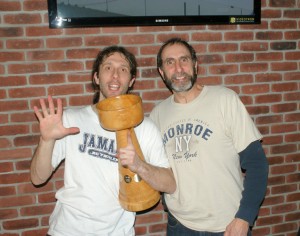
Meanwhile, for the past eleven years and counting (2007-18), Montrealer “King” Carlo Bossio has been the class of classic table hockey. Nobody, not even in this star-studded era, has been able to dethrone him.
That’s the perennial challenge of table hockey, just like any other sport: Be your best, and maybe one day you’ll be the best.
Photo: Lou presents Carlo with his 6th consecutive Quebec Cup.
How did Carlo rise to such dominance in this new era? Read on …




